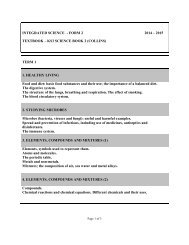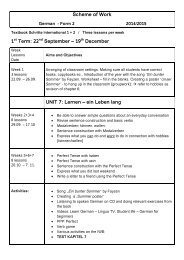Geography - Scheme of Work 2012-2013 Scheme of Work – Form 2 ...
Geography - Scheme of Work 2012-2013 Scheme of Work – Form 2 ...
Geography - Scheme of Work 2012-2013 Scheme of Work – Form 2 ...
- No tags were found...
Create successful ePaper yourself
Turn your PDF publications into a flip-book with our unique Google optimized e-Paper software.
<strong>Geography</strong> SOW <strong>–</strong> <strong>Form</strong> 2 St Joseph School Blata l-Bajda 2014-2015Teaching Block 3: Water, Water Everywhere(approx. 7 weeks + 2 exam weeks)Lesson Title Objectives ActivitiesWater CycleTypes <strong>of</strong> RainfallHelp studentsenquire about thecomponents andlinks within thehydrological cycleHelp students toidentify thedifference betweensalty and fresh wateras well as distinguishand explain the threetypes <strong>of</strong> rainfall- Introduce and recall what they remember <strong>of</strong> the water cycle and showing videos emphasising themain keywords. Students watch an animation <strong>of</strong> the hydrological cycle and note new vocabulary.- As work exercises they can do the following: They draw an annotated diagram <strong>of</strong> the hydrologicalcycle to define the various stages while other students can construct also a concept map <strong>of</strong> the cycle.AND Teacher divides students into groups and provides each group with a list <strong>of</strong> descriptionspertaining to the hydrological cycle such as: Water in the form <strong>of</strong> water vapour, goes fromvegetation into the atmosphere; The transfer <strong>of</strong> water from the air to the land; Water runs <strong>of</strong>f thesurface <strong>of</strong> the land and flows back to the ocean in rivers etc. Ask students to write the correctgeographical key word next to each description. As an alternative, students can also be providedwith additional labels that correspond to these descriptions and their task will be to match them.- The teacher shows different pictures and students choose those in which they can see water. Thestudents are encouraged to identify salty water (sea and oceans) and fresh water (rivers, waterfalls,ponds and lakes).- In groups students examine animations and video clips to gain an understanding <strong>of</strong> the threedifferent ways by which air can be forced to rise and produce relief, convectional and frontalrainfall.
















